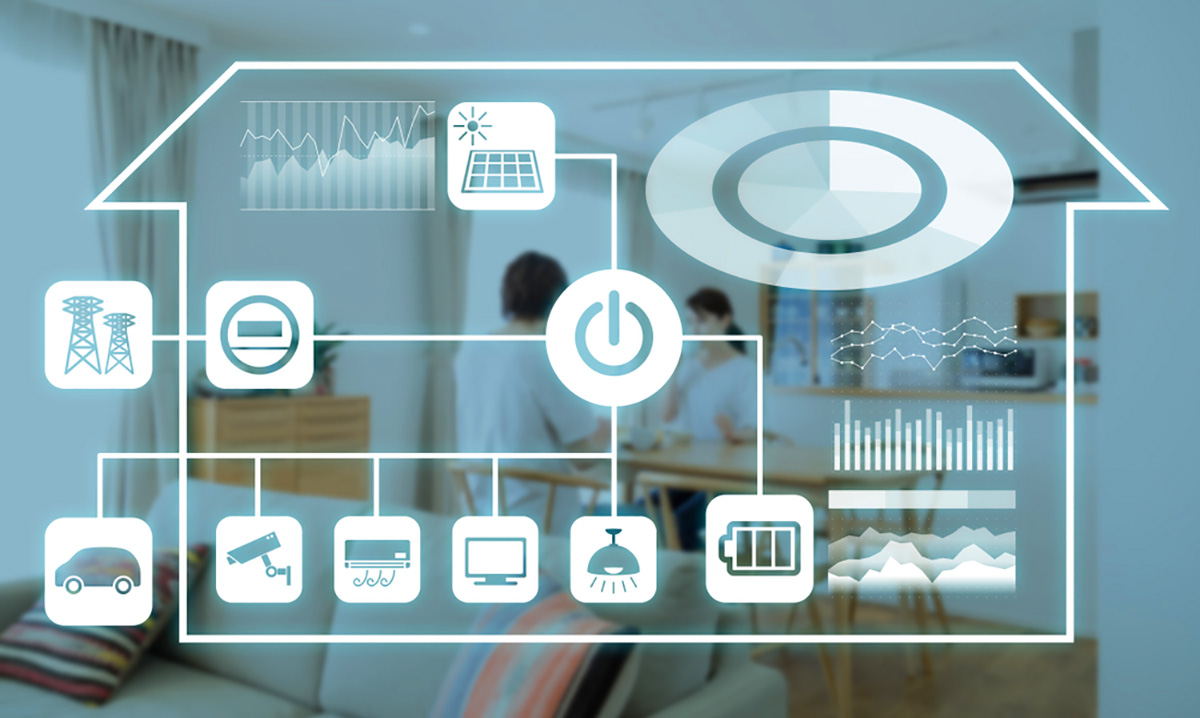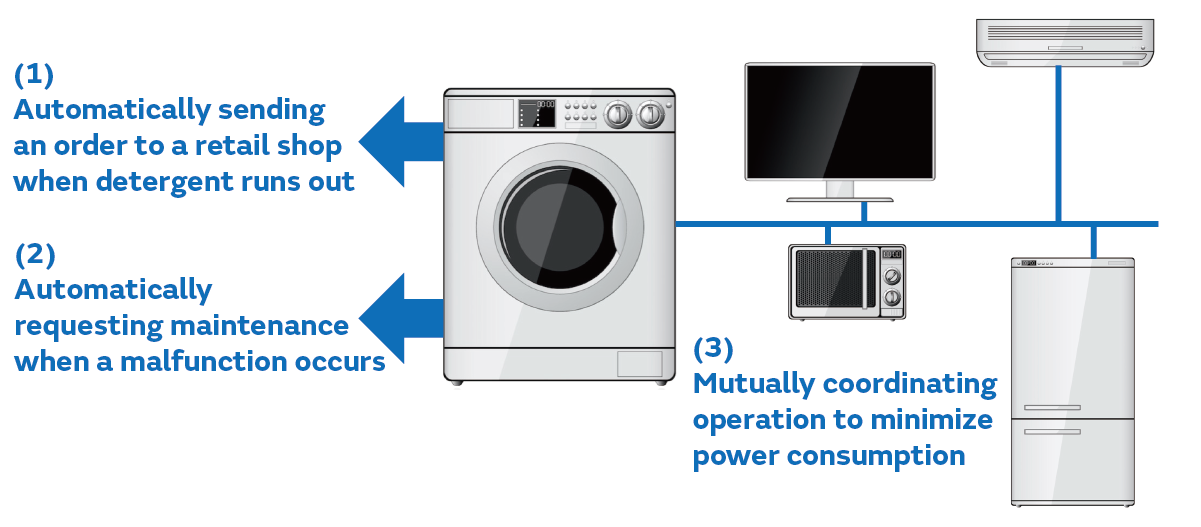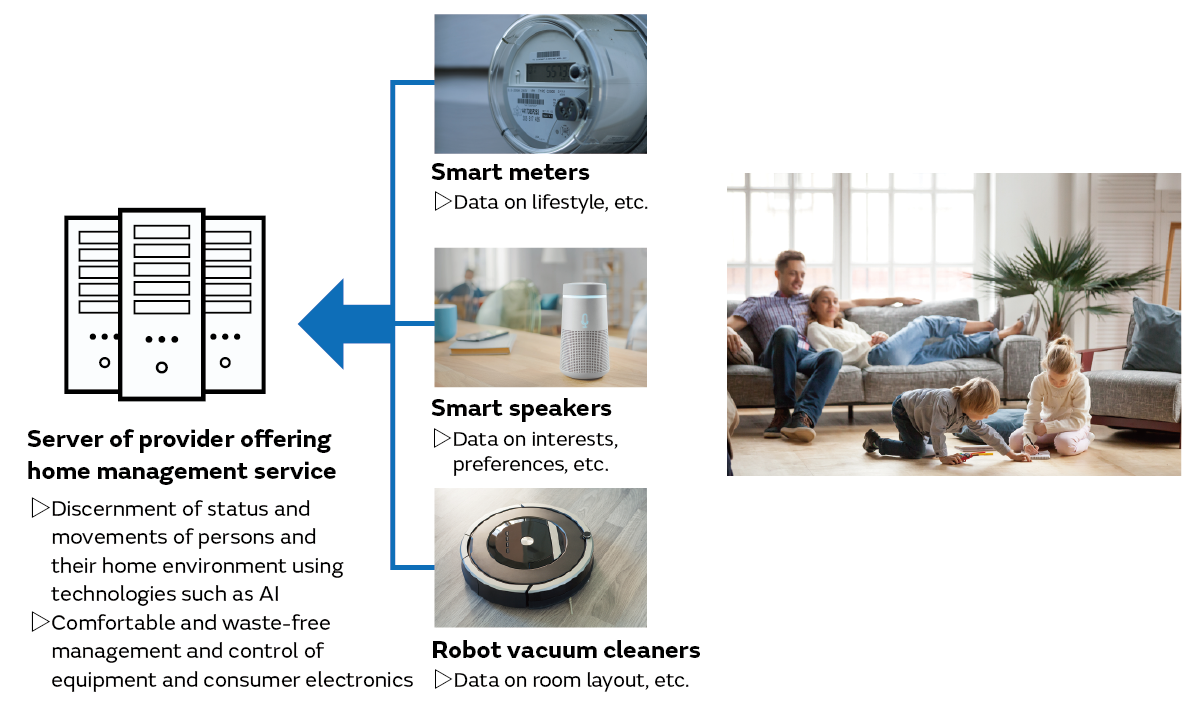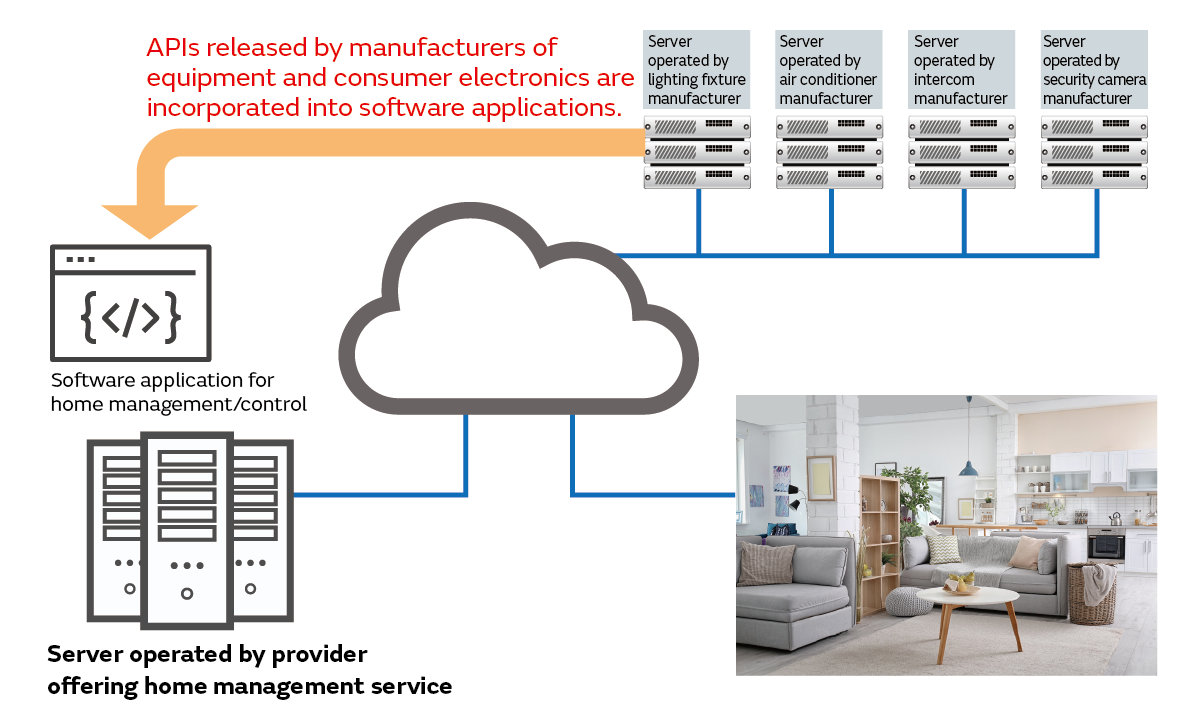Electronic Technology Supporting the Evolution of “Next Tech”
“Home Tech” Creates Comfortable and Sustainable Living Spaces Based on Data
In the 20th century, rapid advances in household equipment and consumer electronics products made more comfortable living spaces possible while freeing us from the drudgery of many household chores. This gave rise to more free time that could be devoted to peaceful contemplation, self-improvement, and exploring favorite pursuits. In the 21st century and beyond, expectations for living spaces will continue to change in major ways, reflecting changes in lifestyle and the social environment.
Throughout most of the developed world, the number of dual-income households is increasing due to more diverse work styles and lifestyle changes. At the same time, the trend toward a declining birth rate and a growing proportion of elderly people continues, with an ever-increasing number of elderly people living alone. As a result, there is an increasing need not only for more efficient ways to deal with household chores and the like, but also for homes to incorporate functionality for ensuring safety and peace of mind, for watching over children and the elderly, and for managing the health of the family. Furthermore, the effects of accelerating efforts worldwide to achieve decarbonization have reached the home as well, as increasing attention is being paid to reducing energy consumption and ensuring effective utilization of resources in our everyday lives. The age of pursuing an affluent lifestyle based on mass consumption of energy and resources is coming to an end, and a new age focused on achieving a sustainable living environment is emerging.
In response to this need, efforts aimed at making use of the latest technologies such as IoT and artificial intelligence (AI) to achieve a sustainable and affluent living environment are becoming ever more active. Here we describe a movement known as “Home Tech” that encourages these efforts through the development of technology for use in the living spaces of the near future (Figure 1).

Linking household equipment and consumer electronics devices that worked individually via a network to enable them to work together
The term “Home Tech” is a neologism coined from the words “home” and “technology.” It refers to the use of technology to realize a living environment that is more comfortable and convenient while also being sustainable in terms of affordability, health, and the global environment. A home incorporating Home Tech is called a “smart home.” Also, the term “home automation” is sometimes used to refer to technology for automating tasks within living spaces that traditionally were performed by persons, such as household chores.
Up to now, most household equipment and consumer electronics products such as refrigerators and air conditioners have functioned independently of other devices. It is necessary to manage and operate each one individually, and this sometimes results in wasteful situations such as lighting fixtures brightly illuminating unoccupied rooms. It is of course possible for people to reduce waste by operating appliances and the like with great care, but this means that minimizing waste can be very time-consuming because every device in the home needs to be operated individually. As a result, much of the time we simply overlook the waste taking place.
By contrast, with Home Tech, if the equipment and devices are connected to a home network, they can interoperate with devices or computers. This means, for example, that sensors placed throughout the home can detect the status of the various rooms and residents, making it possible to turn off the lights in rooms where no one is present or to monitor the comfort level of residents and adjust the temperature accordingly. When a device detects that it is likely to fail, it could send out a request for maintenance on its own. In a more sophisticated example, a washing machine could detect when the stock of detergent is running low and automatically order more from an online shopping site (Figure 2).

Gathering data about people’s lifestyles and interests, including the layout of their homes
An important aspect of Home Tech is whether it can accurately track the status of people and their homes in real time and use this data to control equipment and consumer electronics in a way that is both efficient and sophisticated. The starting point of it all is data gathered by sensors. Three advanced examples of Home Tech that show what kinds of data can be gathered and how it can be put to use are presented below: smart meters, smart speakers, and robot vacuum cleaners (Figure 3).

Smart meters are meters for utilities such as electric power, gas, or water that are connected to a network so that the usage data can be read remotely. Since the measured data is strongly related to the lifestyle and activities of the occupants of the home, it constitutes a valuable information source for putting Home Tech into practice. Systems using trends gleaned from power meters to monitor the well-being of elderly persons have already been implemented. In addition, arrangements for sharing power between homes based on power consumption data measured by smart meters and home storage battery charge level data have been instituted in Europe and America. Measures such as storing power late at night, when costs are lower, for use during the day are providing real cost benefits.
Smart speakers send natural language commands from users to the cloud, where they are recognized and interpreted by AI. This enables users to use their voice to do things like requesting a weather forecast or operating consumer electronics devices connected to the network. Search engines that people use on devices such as smartphones are powered by AI technology that learns the search terms users input and discerns their interests and preferences, enabling them to provide more relevant search results. Similarly, smart speakers collect data useful for the implementation of Home Tech by listening to the conversations of household members in their actual living environment. These capabilities have advanced to the stage where it is possible to read a person’s mood or psychological state based on the characteristics of the speaker’s voice or to discern the mood in a room in which a large number of people have gathered and are conversing with each other.
Robot vacuum cleaners are already familiar to many consumers as a convenient means of escaping the drudgery of household chores and maintaining a clean and tidy living space. Today’s robot vacuum cleaners are equipped with clever functions that use sensors to recognize the room layout, location of furniture, and so on. They then create a digital map that enables them to efficiently clean even complex room layouts without missing anything. Such data on conditions within the home is useful in implementing effective Home Tech solutions.
As these examples show, it is now possible to collect multifaceted data on households and homes, ranging from information on lifestyle, preferences, and interests to the layout of the rooms in the home. Recent advances in information processing technology such as artificial intelligence (AI) enable the above data to be analyzed by a home server or in the cloud to facilitate more convenient and waste-free utilization of household equipment and consumer electronics devices.
Using APIs to link devices from different manufacturers
Technologies for connecting household equipment and consumer electronics products to a network include both wired standards such as Ethernet and an array of wireless technologies with various features, such as Wi-Fi®, Bluetooth®, ZigBee, and Z-Wave, the latter two providing enhanced power efficiency. In addition to these technologies, a means to enable interoperation among products from different manufacturers is becoming necessary.
Devices such as smart speakers or smartphones are widely used as direct interfaces between the members of the household and the home. To enable devices from different manufacturers to interoperate, IT companies that provide virtual assistants that allow users to operate product or communicate via voice or gestures are working together to develop industry-standard communication protocols. In Japan, a number of companies are participating in a consortium promoting the adoption of such a protocol, known as ECHONET Lite.
The public release of “API links” has proliferated in recent years as a way to increase the availability of voice-operated equipment and consumer electronics that can be controlled using smart speakers or smartphones (Figure 4). API stands for “application programming interface,” and APIs provide a way to share software functionality. A manufacturer selling a device intended to interoperate with other devices will release an API that can be integrated into software applications that manage or control aspects of the home environment. This makes interoperation between the first device and devices running the software applications possible. By using APIs, any device that can connect to the internet can interoperate with other devices.
As the number of categories of household equipment and consumer electronics products capable of interoperation grows, the scope of possible applications for Home Tech will broaden and adoption will accelerate. Home Tech is a foundation on which to build a comfortable living environment and an affluent lifestyle, and by making this possible in an efficient and sustainable way, it brings important benefits both for consumers and for the global environment.


